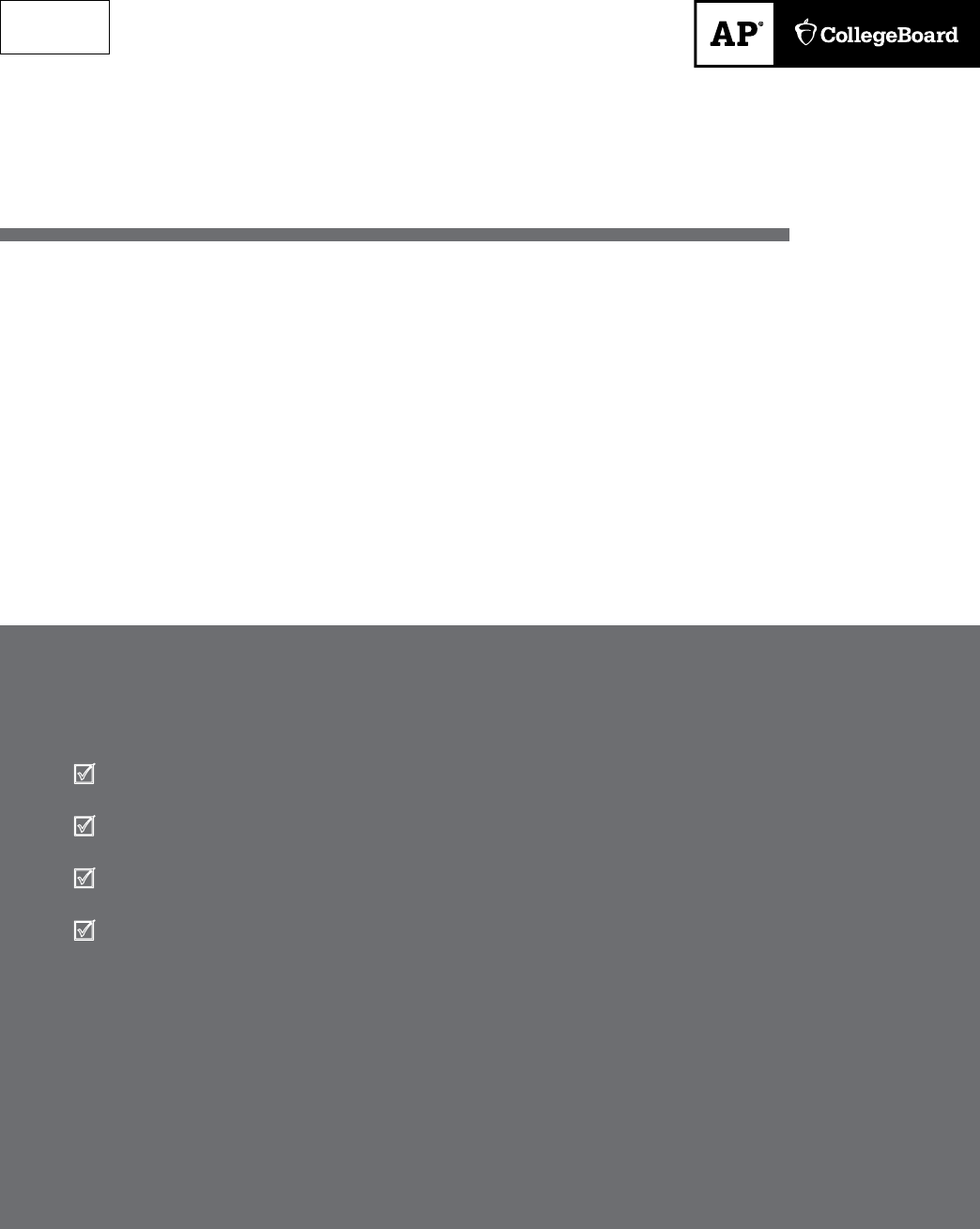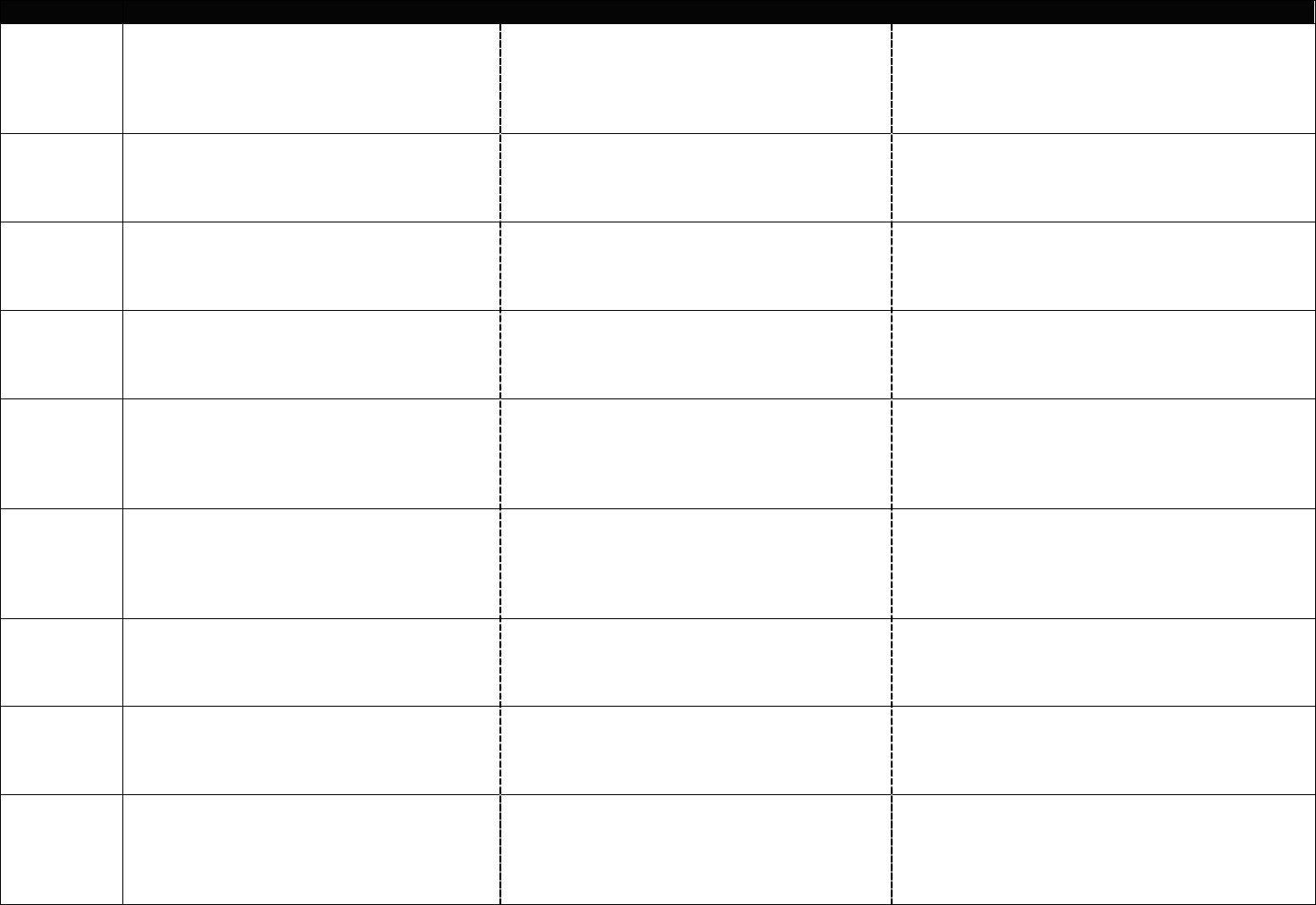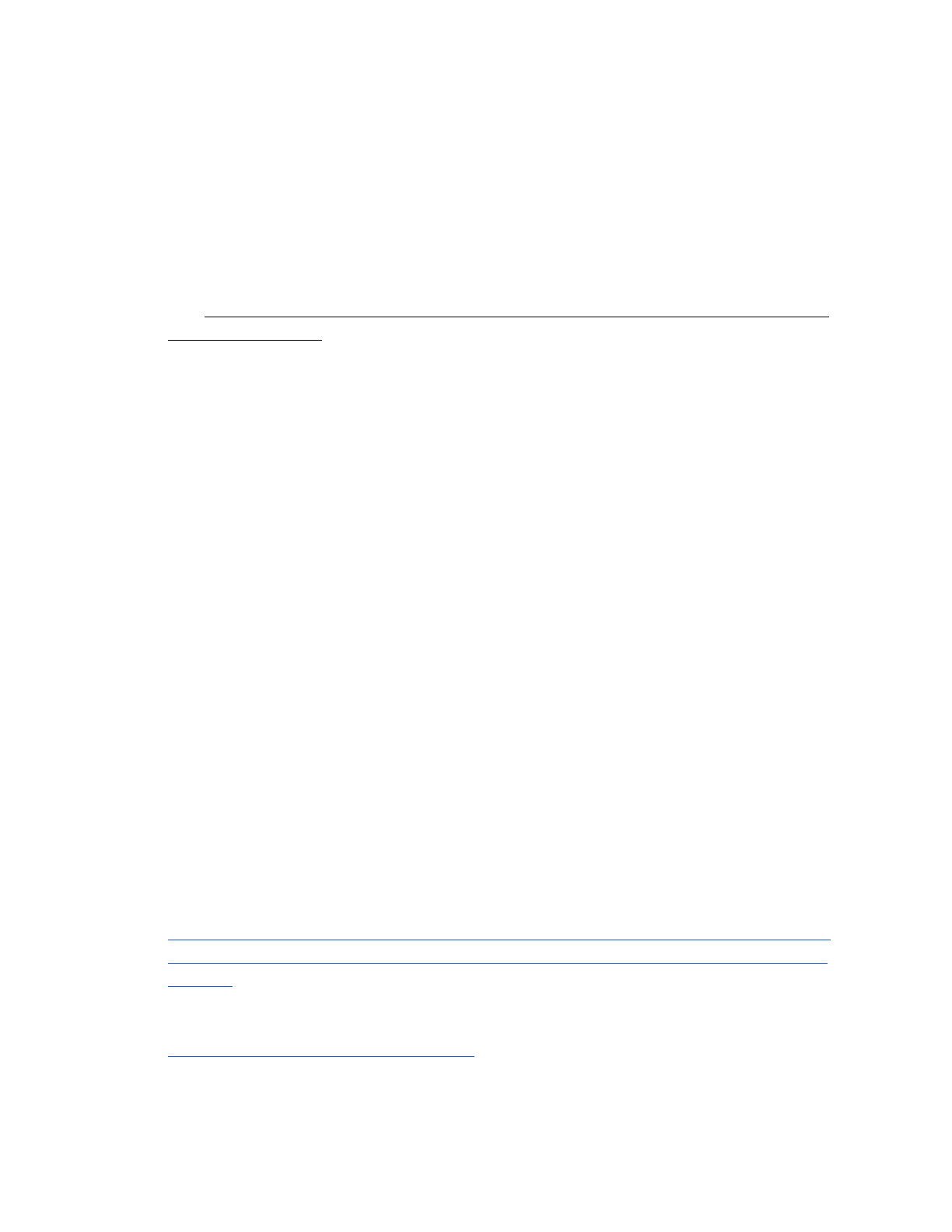
2017
AP Research
Academic Paper
Sample Student Responses
and Scoring Commentary
Inside:
• Sample A
• Scoring Guideline
•
Student Samples
•
Scoring Commentary
© 2017 The College Board. College Board, Advanced Placement Program, AP, AP Central, and the acorn logo
are registered trademarks of the College Board. Visit the College Board on the Web: www.collegeboard.org.
AP Central is the ocial online home for the AP Program: apcentral.collegeboard.org

AP
®
RESEARCH 2017 SCORING GUIDELINES
Performance Task Rubric: Academic Paper
Content Area Performance Levels
1 Understand
and Analyze
Context
The paper identifies a broad topic of inquiry
and/or a purpose.
2
The paper identifies a focused topic of inquiry and
describes the purpose.
4
The paper explains the topic, purpose, and focus of the
inquiry and why further investigation of the topic is
needed by connecting it to the larger discipline, field,
and/or scholarly community.
6
2 Understand
and Analyze
Argument
The paper identifies or cites previous scholarly
works and/or summarizes a single perspective on
the student’s topic of inquiry.
2
The paper summarizes, individually, previous
scholarly works representing multiple perspectives
about the student’s topic of inquiry.
4
The paper explains the relationships among multiple
scholarly works representing multiple perspectives,
describing the connection to the student’s topic of
inquiry. 6
3 Evaluate
Sources and
Evidence
The paper uses sources/evidence that are
unsubstantiated as relevant and/or credible for
the purpose of the inquiry.
2
The paper uses credible and relevant
sources/evidence suited to the purpose of the
inquiry.
4
The paper explains the relevance and significance of
the used sources/cited evidence by connecting them to
the student’s topic of inquiry.
6
4 Research
Design
The paper presents a summary of the approach,
method, or process, but the summary is
oversimplified.
3
The paper describes in detail a replicable
approach, method, or process.
5
The paper provides a logical rationale for the research
design by explaining the alignment between the
chosen approach, method, or process and the research
question/project goal. 7
5 Establish
Argument
The paper presents an understanding, argument,
or conclusion, but it is simplistic or inconsistent,
and/or it provides unsupported or illogical links
between the evidence and the claim(s).
3
The paper presents a new understanding,
argument, or conclusion that the paper justifies by
explaining the links between evidence and claims
derived from the student’s research.
5
The paper presents a new understanding, argument, or
conclusion that acknowledges and explains the
limitations and implications in context.
7
6 Select and
Use Evidence
Evidence is presented, but it is insufficient or
sometimes inconsistent in supporting the paper’s
conclusion or understanding.
2
The paper supports its conclusion by compiling
relevant and sufficient evidence generated by the
student’s research.
4
The paper demonstrates an effective argument
through interpretation and synthesis of the evidence
generated by the student’s research, while describing
its relevance and significance.
6
7 Engage
Audience
Organizational and design elements are present,
but sometimes distract from communication or
are superfluous.
1
Organizational and design elements convey the
paper’s message.
2
Organizational and design elements engage the
audience, effectively emphasize the paper’s message
and demonstrate the credibility of the writer.
3
8 Apply
Conventions
The paper cites and attributes the work of
others, but does so inconsistently and/or
incorrectly.
2
The paper consistently and accurately cites and
attributes the work of others.
4
The paper effectively integrates the knowledge and
ideas of others and consistently distinguishes between
the student’s voice and that of others.
6
9 Apply
Conventions
The paper’s use of grammar, style and mechanics
convey the student’s ideas; however, errors
interfere with communication.
1
The paper’s word choice and syntax adheres to
established conventions of grammar, usage and
mechanics. There may be some errors, but they do
not interfere with the author’s meaning.
2
The paper’s word choice and syntax enhances
communication through variety, emphasis, and
precision.
3
Page 1 of 2
© 2017 The College Board.
Visit the College Board on the Web: www.collegeboard.org.

AP
®
RESEARCH 2017 SCORING GUIDELINES
Performance Task Rubric: Academic Paper
NOTE: To receive the highest performance level presumes that the student also achieved the preceding performance levels in that row.
ADDITIONAL SCORES: In addition to the scores represented on the rubric, readers can also assign scores of 0 (zero).
- A score of 0 is assigned to a single row of the rubric when the paper displays a below-minimum level of quality as identified in that row of the rubric.
© 2017 The College Board.
Visit the College Board on the Web: www.collegeboard.org.
Page 2 of 2
AP
®
RESEARCH
2017 SCORING COMMENTARY
Academic Paper
Overview
This performance task was intended to assess students’ ability to conduct scholarly and responsible
research and articulate an evidence-based argument that clearly communicates the conclusion,
solution, or answer to their stated research question. More specifically, this performance task was
intended to assess students’ ability to:
• Generate a focused research question that is situated within or connected to a larger
scholarly context or community;
• Explore relationships between and among multiple works representing multiple perspectives
within the scholarly literature related to the topic of inquiry;
• Articulate what approach, method, or process they have chosen to use to address their
research question, why they have chosen that approach to answering their question, and
how they employed it;
• Develop and present their own argument, conclusion, or new understanding while
acknowledging its limitations and discussing implications;
• Support their conclusion through the compilation, use, and synthesis of relevant and
significant evidence generated by their research;
• Use organizational and design elements to effectively convey the paper’s message;
• Consistently and accurately cite, attribute, and integrate the knowledge and work of others,
wh
ile distinguishing between the student’s voice and that of others;
• Generate a paper in which word choice and syntax enhance communication by adhering to
established conventions of grammar, usage, and mechanics.
© 2017 The College Board.
Visit the College Board on the Web: www.collegeboard.org.

Sample A
GROWTH FOR GOOD: HOW PAST EXPERIENCES MOTIVATE EXECUTIVES TO JOIN
DOUBLE BOTTOM LINE ORGANIZATIONS IN THE INDIAN CONSTRUCTION
INDUSTRY
WordCount:5183
Abstract
ResearcherAnthonyBiscontidefinestheunorthodoxcompaniescalleddoublebottomline(DBL)
organizationsasbusinesseswhichdogoodforsocietywhileearningprofit(Bisconti,2009).Since2001,the
amountoftheseorganizationshasstartedtoincreaseintheIndianconstructionindustry.Bythematically
analyzingthenarrativesofeightexecutivesworkinginIndianconstructionDBLorganizations,Iseekto
understandthereasonforthisgrowth.Specifically,thisstudylooksatimportanteventsinanexecutive’slife
inordertounderstandhowexperiencesmotivateexecutivestojoinIndianDBLorganizationswithinthe
constructionindustry.Throughinterviewswitheightexecutivesworkinginthissector,Icollectedmultiple
narrativesdetailinghowpastexperiencesinfluencedthedecisiontoworkwiththedoublebottomline.Witha
thematicanalysis,Idrewconnectionsbetweencommonthemesarisingfromthenarrativesinordertofind
thetypesofexperienceswhichfunctionedasmotivatorstojoinaDBLorganization.Thispaperwaswritten
withtheinitialassumptionthatexperiencesandeventsrelatingtopovertywouldmakepeoplemoreproneto
joiningaDBLorganization.Throughtheresearchprocess,however,itwasinsteadrevealedthatexperiences
basedoffaneedtoselfactualize-definedasthedesiretouseone’sskillsforsocialimpactratherthanprofit-
catalyzedthedesiretoworkwithaDBLorganization.Therefore,thisstudyconcludesthatexperiences
relatedtodoinggoodforsocietyengenderthemotivationtojoinaDBLorganization.Thisresearchindicates
thatcertainexperiencesdo,infact,playaroleinmotivatingexecutivestojoinDBLorganizations.Therefore,
itcanbeusedinordertounderstandhowtobestaugmentthegrowthofDBLorganizationsintheIndian
constructionindustry.
© 2017 The College Board.
Visit the College Board on the Web: www.collegeboard.org.
1 of 15
Sample A 2 of 15
Introduction
AlthoughIndiahasthesecondlargestconstructionindustryintheworld,only20%ofitstotal
workforceareapartoftheorganizedsector(Nihas,2013).Theorganizedsectoriscomprisedofbusinesses
whicharepubliclylisted,andthereforecanberegulatedbythegovernment(Nihas,2013).Theother25
millionworkersoperateintheunorganizedsector,meaningtheyarehiredbyunincorporatedbusinesses
(Nihas,2013).Thisfragmentationoflaborhasmaderegulationoftheindustrydifficult,asgovernment
institutionshavenowayofofficiallycataloguingthecompaniesintheunorganizedsector(Tiwaryetal,2012).
Moreover,thelackofbothfederalmonitoringandefficientlaborlawshasmadeiteasyforthe
aforementionedcompaniestoabuseworkers(Tiwary,2011).Overtime,thishascausedanepidemicof
humanrightsviolationswhichdirectlyimpactsthelivesofmanyimpoverishedIndians.Asofnow,thereis
littleanyonecandotoprotecttherightsofIndianlaborers.Thegovernment,duetorampantcorruption,is
inefficientinregulatingtheunorganisedsector(Betancourtetal,2013).Nongovernmentalorganizations
(NGOs)havehadsomesuccessinbringinghumanrightstotheindustry,buttypicallywithdrawbecauseof
theirdependenceondonationsandthirdpartyfunding(Chung,2008).Althoughboththesepartieshavehad
limitedsuccess,businessesknowndoublebottomlineorganizationshavebeeninstrumentalincausingsocial
changewithinthemarket(Afsharipour,2013).
Itiswidelybelievedthatdoublebottomlinebusinessescanbringaboutsocietalchangewithinan
industry(Jue,2015).Doublebottomline(DBL)organizationsareessentiallycompanieswhichearnprofit
whiledoinggoodforsociety.Indeed,Biscontidefinesthedoublebottomlineas“awaytodescribeasocial
enterprise'sbalanceoffinancialviabilityandsocialimpact.”(Bisconti,2009). Therearemanyexamplesof
suchcompaniescurrentlydoingsocialworkwhileearningprofitinIndia.Intheconstructionindustry,for
example,someDBLorganizationseducatetheirlaborersonworkplacesecurity.Othersmayprovidethem
withvocationaltraining(Char,2011).
InIndia,DBLorganizationshavestartedtogrowinnumber(Bos,2015).Whiletheriseofthese
businessesiswelcomeinsociety,itisalsopuzzling.Thisisbecauseconventionally,socialenterprisesofall
formspaylessthanconventionalbusinessesduetotheirneedtosacrificeprofitforsocialimpact(Char,
2011).DBLorganizationsarenoexceptiontothisrule.Asaresult,theyofferlowercompensationpackages
toexecutiveswhojointhem,andaremoredifficulttosustainthanafor-profitorganization(Afsharipour,
2013).However,despitetheobviousdisadvantagestojoiningthem,trainedprofessionalsareforgoingwork
atconventionalbusinessesforajobwithaDBLorganization(Sodhietal,2011).Thisgrowthindicatesthat
somethingotherthanprofitmotivatesentrepreneurstojoinDBLorganizations-perhapssomethingsuchas
anexecutive’spastexperiences.Therefore,itisinourbestintereststoinvestigatehowpastexperiences
motivateexecutivestojoinbusinessesadoptingthedoublebottomlinemetric.
© 2017 The College Board.
Visit the College Board on the Web: www.collegeboard.org.
Sample A 3 of 15
LiteratureReview
Inordertounderstandwhythisstudyanalyzesthepastexperiencesofexecutivesandhowthey
influenceaDBLorganization’sgrowth,itisimportanttolookattheexistingbodyofresearchonthesubject.
Therearecurrentlyfewstudieslookingathowtheseexperiencesfunctionasmotivators,however,some
studiessuggestthattheybuildapositivereputationforthemselvesinordertobecomemorepopularand
thereforegrowmore(Douglas,2010;Lee,2015).ThesestudieslookathowDBLorganizationsbuilda
publicimageforthemselvesinordertogainsupport.AsconcludedbyLee,“thegrowthofsocialenterprises
inSouthKoreaisattributedtothecountry'scharacteristicallystrongcentralgovernmentanditscreationof
relevantinstitutionsandprovisionofsupportservices”.ThisstudysuggeststhatDBLorganizationsareable
togrowbydevelopingastrongpublicimaginewhich,inturn,allowsthemtoaccessresourcesthataidtheir
development.Similarly,Douglasassertedintheirresearchthat“institutionalidentityproblems”foraDBL
organization“reduceexternalappreciation”.JustlikeLee,Douglas’workshowshowaDBLorganization’s
publicimageiscriticaltowardsitsgrowthandsuccess.Inessence,boththesestudiesconcludethatDBL
organizationsexperiencegrowthbypromotingapositivepublicimagine.Thestudies,however,arelimitedas
theydonotexaminewhatmotivatesexecutivesthemselvestojoinaDBLorganization.Rather,Leeand
DouglasprovideexplanationsforhowDBLorganizationsmaygrowbygarneringmorefundsorapproval.
UnlikethestudiesconductedbyLeeandDouglas,researchexaminingwhyexecutivesthemselves
leavethe
irjobsforworkataDBLorganization-andthereforeengendergrowth-doesexist.(Pulasinghe,
2010;Alfaroetal,2012,).ThesestudiescollectasampleofentrepreneursworkinginNGOsorDBL
organizationsandthengroupthembasedontheircommontraits.Theythenconductanalysisontheir
subject’straitsinordertodeterminetheirmotivationtojoinasocialcause.Forexample,Pulasinghe
concludesinherstudyonemployeemotivationinSriLankanNGOsthatexecutivesjoinsocialcauses“since
theyreceivemoreempowermentandrecognitionbyworkingthere”,andduetoa“desiretochangethe
world”(Pulasinghe,2010).Inasimilarvein,Alfaro’sresearchsuggeststhatexecutivesjoinsocial
organizationsbecausetheywanttomakeapositiveimpactonsociety.Inshort,bothoftheseresearchers
analyzehowcommonpersonalitytraitsamongagroupofentrepreneursindicatethetypesofpeoplewhoare
morelikelytojoinasocialcause.Theyassertthatpersonalityplaysalargeroleinanexecutive’sdecisionto
joinasocialcause(suchassocialenterpriseoraNGO).Theyarelimited,however,sincetheydonottake
intoaccounthowexperiencesinanexecutive’spastcouldhaveinfluencedtheirdecisiontojoinaDBL
organization,andsolelyfocusontheirpersonality.Pastexperiences-whichcanhaveamassiveimpactonan
executive’sdecisions-areintegraltoanyentrepreneursmotivation(Simmons,2016).Thus,bynotanalyzing
themthesestudiesdonotfullyrepresenthowexecutivesaremotivatedtojoinsocialcauses.Additionally,the
studiesarefurtherlimitedastheydonotinterviewentrepreneursfromsimilarindustriesandbusinesses.Each
studyaimstoinvestigatethemotivationtojoinasocialcause,andthereforelooksatwhypeoplejoinNGOs,
charities,andeventheUnitedNations.Theirdatathereforerepresentswhyentrepreneursjoinalltypesof
socialorganizationsratherthanjustspecificallyDBLorganizations.
Therefore,whilesomestudiesassertthatthepublicimageofDBLorganizationsiswhatcausesthem
togrow,andothe
rsarguethatpersonalityisintegralinmotivatinganentrepreneurtojoinasocialcause,few
studiestesthowthepastexperiencesofentrepreneursinfluencestheirmotivationtojoinaDBL
organizations.Moreover,giventhelimitationsofpreviousstudies,anyresearchonmotivationsfor
© 2017 The College Board.
Visit the College Board on the Web: www.collegeboard.org.
Sample A 4 of 15
entrepreneursinthefuturemustfocusonaspecificindustry.SeeingasstudieshavenotlookedattheIndian
constructionindustrybefore,futureresearchshouldaimtoexamineDBLorganizationsinthissectorinorder
tobridgethegapinknowledge.Moreover,researchneedstobecenteredaroundentrepreneursratherthan
organizationsasawhole.Altogether,thesefactorsillustrateouragapinourknowledgeofwhypeoplejoin
DBLorganizations,asfewstudiesexaminehowpastexperiencesmotivateexecutivestojoinDBL
organizations,andthegrowthofDBLorganizationintheIndianconstructionindustry.Thisstudywill
attempttobridgethisgapbyaskingthequestion:throughacasestudyonorganizationsintheIndian
constructionindustry,howdopastexperiencesmotivateprofessionalstojoinbusinessesadoptingthe
double-bottomlinemetric?
Myresearchwillthereforebeuniqueasitwillexaminehow pastexperiencesmotivateprofessionalsto
joinDBLorganizations.Asstatedearlier,itwillbelimitedtoDBLbusinessesintheIndianconstruction
industrytotryandprovideanexplanationforthegrowthofDBLorganizationsinthesector.Additionally,
becausepreviousstudieshavenotbeencenteredaroundthisindustryitwillfillthegapinknowledgeonthe
subject.Undertheaboveparameters,thestudywillgatherqualitativedatathroughasetofrecorded
interviewsinordertotestitshypothesis.Specifically,itwillobtainthenarrativesofaroundeightexecutives
fromthreedifferentDBLorganizations.Moreover,theinquirywillnotmentionthenamesandorganizations
ofanyparticipantsinordertoprotectuseranonymity.
Thisstudy’scontributionstoresearchonthetopicwillbesignificantasitwillhighlightthetypesof
experienc
eswhichmakepeoplemorepronetoenterDBLorganizations.Itwillresearchhowthese
experiencescanserveasmotivations,therebycontributingtothepre-existingknowledgebaseonwhypeople
joinsocialcauses.Withthisknowledge,itmaybepossibletotryandencouragemoreprofessionalstojoin
DBLorganizationsintheIndianconstructionindustry.Thiswouldbeinstrumentalincausingsocialchange,
andwouldletusasasocietyknowthetypesofpeoplewhowouldbepronetojoiningsocialenterprise,
allowingtheIndiangovernmenttousethisinformationtoincreasethegrowthofDBLorganizations.Itcould
alsohelptheorganizationsthemselveslaunchcampaignstoattractinterestedprofessionals-further
augmentingtheirgrowth.Altogether,theresultsofthisstudycancontributetoincreasingtheamountof
DBLorganizationsintheIndianconstructionindustryformoresocialbenefitinthefuture.
Hypothesis
Iinitiallyhypothesizedthatexperienceswithexposuresincechildhoodtothestrugglesofthelower
c
lasswouldmotivat
eexecutivestojoinDBLorganizationsintheIndianconstructionindustry.This
hypothesiswasdevelopedbasedonconclusionsofstudiesexaminingtheexecutive’sdecisiontojoinNGOs.
Thesestudiesshowedapositivecorrelationbetweenexposuretopovertyandthemotivationtoworkforan
NGO-thatistosay,theydiscoveredthatpeoplewithexperienceswithpovertyweremorelikelytojoin
NGOs(Young,2013). DuetothesimilaritiesbetweenNGOsandDBLorganizations,Ibelievethat
motivationsofexecutivestojoineithertypeofbusinesswillbeextremelyalike.
Method
© 2017 The College Board.
Visit the College Board on the Web: www.collegeboard.org.
Sample A 5 of 15
Inordertotestthehypothesis,acasestudymethodcontainingnarrativeinterviewsandthena
thematicanalysiswasemployed.Casestudiesarecloseexaminationsoranalysesofpeople,organizations,or
phenomenon(Zucker,2009).Thisresearchfocusedonacasestudyofeightexecutivesrepresentingthree
DBLorganizationsintheIndianconstructionindustry.Thecasestudymethodwasusedtobetteranalyzethe
phenomenonofhowexperiencesinfluencedanexecutive’sdecisiontojoinaDBLorganization.Thepointof
thistypeofmethodwastoanalyzehowexperiencesinfluencedthemotivationtojoinaDBLorganization,so
lookingatthephenomenonthroughthecloseexaminationofferedbyacasestudywastheeasiestwayto
analyzethedata.Furthermore,thecasestudymethodallowedforinformationtobecollected(through
narrativeinterviews)andthenexaminedwithathematicanalysis.
NarrativeInterviews
Inordertocollectdataonthepersonalexperiencesofexecutivesandtotestmyhypothesis,I
conducte
dnarrativeinterviewsasthefirstpartofthecasestudy.Forreference,narrativeinterviewsare
interviewswhichseektoreconstructexperiencesandeventsfromaninterviewee'slife(Jovchelovitch,2007).
TheyfollowaframeworkproposedbytheLondonSchoolofEconomics,andthereforehaveafewspecific
guidelineswhichinterviewersmustadhereto(Jovchelovitch,2007).Primarily,narrativeinterviewsmustask
questionsinchronologicalorder.Thatistosay,theyneedtoaskquestionsabouteventswhich
chronologicallyoccurredfirstbeforemovingontoexploreeventswhichoccurredatlaterdates.Theymust
alsohavenoquestionswhichcanbeansweredbyayesorno,andmustallowanintervieweeampleroomto
elaborateontheirstory.Narrativeinterviewswereselectedtotheprimarymethodofacquiringdataasthey
areabletoeffectivelyextrapolatenarrativesfrominterviewees.Sincemyfinalgoalwastoexaminehowpast
experiencesinfluencedthemotivationofexecutives,Ineededtocollectaccountsoftheseeventsinan
anecdotalform.Therefore,narrativeinterviewswereemployedastheyarespecificallydesignedtohave
intervieweesrecallstoriesorpastevents.
Beforetheinterviews,however,itwasnecessarytofirstselectatargetgroup.Asstatedearlier,eight
execut
ivesworkinginthreedifferentDBLorganizationswereexaminedforthestudy.Organizationsto
requestinterviewsfromwereselectedonlyiftheyfollowedthedoublebottomlinemetricofsuccess-thatis
tosay,iftheyfocusedonbothearningprofitandhavingasocialimpact.TheyalsohadtobeintheIndian
constructionindustryinordertobridgethegapinknowledgeonDBLorganizationsinthatparticularsector.
Moreover,theyhadtoconsiderthemselvesDBLorganizations,andexplicitlystateintheirmissionstatement
thedesiretodogoodforsocietywhileearningaprofit.ThethreeDBLorganizationschosenforthisstudy
all,therefore,fittheaboveparameters.Additionally,eachorganizationwastakenfromalistofDBL
organizationsrecognizedbytheIndiangovernment,andgenerallyhadthesamebusinessmodel.Inessence,
allthreeprovidedlivelihoodsforruralyouthbyequippingthemwithconstructionskills,andwouldearn
profitbycontractingtheseyouth-turned-workerstobuildsites.Aftertheidentificationprocesswascomplete,
interviewswithexecutivesrepresentingthesecompanieswereorganized.Around2-3executiveswere
selectedfromeachbusiness-andintotal,thismeantthat8executivesfrom3differentorganizationswere
interviewedaspartofthestudy.
Thegoalofeachinterviewwastodeterminewhichexperiencesinanexecutive’slifecontributedto
theirdec
isiontojoinaDBLorganization.Assuch,allinterviewsfeaturedthesame15questionsonan
© 2017 The College Board.
Visit the College Board on the Web: www.collegeboard.org.
Sample A 6 of 15
executive’spastexperiences,andwereallconductedthroughaphonecall.Thequestionswereallopened
endedsothatintervieweeshadopportunitytoelaborateontheiranswers,andweredesignedwiththehelpof
theLondonSchoolofEconomics’narrativeinterviewguidelines(Jovchelovitch,2007). Theywerealso
categorizedintothreegroups-earlylife(5questions),Universityyears(4questions),andadulthood(6
questions).Theearlylifecategoryaskedintervieweesaboutexperiencesfromwhentheywerebornupuntil
age16,theuniversitycategorynaturallydealtwitheventsoccurringduringtheircollegeyears,andthe
adulthoodsegmentquestionedexecutivesabouteventsoccurringbetweenafterUniversityandbeforethey
joinedtheirrepresentativeorganization.Ididthisinordertogainawidespectrumofthetypesofevents
whichcouldhavemotivatedanintervieweetojoinaDBLorganization.
ThematicAnalysis
Afterthenarrativeinterviewswereconducted,theresearchmovedontothesecondstepofthecase
study-qualit
ativethematicanalysis. Thematicanalysisisamethodofanalysiswhichdeterminesa
relationshipbetweencommonthemesinasampleofcollecteddata(Thomas,2007).Forthepurposesofthe
study,thismethodwasusedtoanalyzetheexperiencespresentedbytheexecutivesintheirinterviews.Itdid
thisbyidentifyinghowcommonthemesacrosstheinterviewee’sdifferingnarrativescontributedtoan
interestinDBLorganizations.
Thethematicanalysiswassplitintotwosections.Firstly,similarexperienceswereidentifiedamong
theinte
rviewedexecutives.Thesesimilarexperiencesindicatedthetypesofcommoneventswhichoccurred
toexecutiveswhodecidedtopursuecareersinaDBLorganization.Theoverallgoalofthisprocesswasto
determinethetypesofeventswhichmotivatedexecutivestojoinaDBLorganization.Intheinterviews,
however,executivessometimescitedeventswhichwereimportanttothembutnottotheirdecisiontojoina
DBLorganization-likemarriage,orsportstournaments.Theseeventswereomittedfromanalysis,asonly
experienceswhichdirectlycontributedtoanexecutive’sdecisiontojoinaDBLorganizationweresignificant
forthepurposesofmyresearch.Afterthisinitialstageofidentifyingrelevantcommonexperienceswas
complete,Imovedontothenextpartofthequalitativethematicanalysis.Forthissecondsegmentofthe
research,thecommonexperienceswereanalyzedforhowtheycouldcontributetoanexecutive’smotivation
tojoinsocialenterprise.Inthisstep,similarexperienceswerecategorizedintogroups.Eachgroupwasthen
labeledwithanoverarchingtheme,whichIusedinmyanalysisofhoweventsinfluencedanexecutive’s
motivation.Hence,thisresearchmethodwasusedtoidentifycommonthemesamongstthenarrativesof
executives,whichwereanalyzedtodeterminehowtheycontributedtoanemployee’smotivation.
Thematicanalysiswasthesecondstageofthiscasestudyasitwasthebestwaytoanalyzethedata
presente
dfromthenarrativeinterviews.Sincethisstudy’sobjectivewastofindouthowexperiences
motivatedexecutivestojoinIndianDBLorganizations,analyzingthecommonthemeswouldindicatethe
types ofexperienceswhichwouldmakeprofessionalsmorepronetojoiningaDBLorganization.Athematic
analysisdoesthisbyidentifyingthecommonthemeswithinasamplesize-henceitwasemployedforthe
research.
Findings
© 2017 The College Board.
Visit the College Board on the Web: www.collegeboard.org.

Sample A 7 of 15
Beforemovingontodiscusstheimportanceofcodingthedataintosuchatable,weneedtofirst
clarifywhateachthememeans.Fromalleightnarratives,atotaloffivethemesemerged.Thesethemesand
theirdefinitionshavebeencodedintothetablebelow.
Table1:DefinitionsofThemes
Theme
Definition
Service
Communityservicerelatedexperiences,suchas
donatingtothecharitiesordoingsocialwork.
Education
Experienceswithworkinginthefieldofeducation.
Examplesofthisincludeworkingasateacher,or
havingajobinaschool.
Travel
Experienceswithtravelingawayfromhome.
Selfactualization
Experiencesinwhichanexecutiverealizedthatthey
wantedtoselfactualize.Selfactualizationisdefined
asthedesiretouseone’stalentsandabilitiestothe
fullestextent.Inthiscase,experienceswhenan
executiverealizedthattheywantedtodousetheir
skillsetformorethanjustearningmoney.
Poverty
Experiencesinwhichanexecutivehadtosurvive
poverty.Examplesofthiswouldincludegrowing
upinalowerclassfamily,orhavingtoskipschool
inordertoearnmoneyforfood.
Theresultsfromthenarrativeinterviewswerecompiledintothetablebelow.
Table2:ASummaryoftheEightInterviews
Executive#
KeyEventsfromtheExecutive’sPast
CorrespondingThemes
1
Listeningtotheirfathertalkaboutthestrugglesofcommon
workers,andhowthepoorhadtobehelped.
TriptoruralIndia,whereheobservedextremepoverty
Workingformicrofinancebusiness
Service
Travel
2
Whentheirparents’businessfailed,theybecame
impoverishedupuntilHighSchool.
Importanceofeducationwasstressedthroughoutlife,tothe
pointwheretheybecameateacher
Poverty
Education
© 2017 The College Board.
Visit the College Board on the Web: www.collegeboard.org.

Sample A 8 of 15
DecidedtojoinDBLbecausewantedtousetheirteaching
skilltoempowerthedisadvantaged.
Selfactualization
3
Waspushedbytheirparentstostudyhardandsucceed,and
becameateachingassistantattheirUniversity.
RealizationthattheydidnotwanttoworkasanEngineer,
andwantedtousetheirskillforsocialgood.
Education
Selfactualization
4
TravelingtoruralareasinIndiaandEuropeasateen,and
beinginspiredtodosocialgood.
StartingaventureinIndiawhichwouldbringsanitationto
girls’schools.
Travel
Service
5
Importanceofeducationwasstressedsincechildhood,
whichinspiredthemtobecomeaVicePrincipalofaschool.
Realizationthattheywantedtousetheirskillsinorderto
empowerthepoor,notsimplyearnmoney.
Education
Selfactualization
6
TraveledtoIndonesiaasanemployeeofamultinational
organization,wheretheytrainedfactoryworkers.
Realizationthattheydidnotwanttobeaschoolteacher,
andinsteadwantedtohelpthepoor.
Education
Travel
Selfactualization
7
BeginningaventureinIndiawhichwillseektogiveworkers
properrights.
Growingupinalower-classfamily.
Service
Poverty
8
Asateen,attendedmultiplehumanrightsprotestswith
theirsibling,andcampaignedforequalitybetweengenders.
Realizationthattheirtalentswerenotappreciatedby
anybodyintheircompany,andthattheywantedtomakea
differenceintheworldthroughcommunityservice.
Service
Self-actualization
Asstatedbefore,8executivesfrom3differentcompanieswereinterviewedonimportanteventsin
theirpastwhichledtotheirdesiretojoinaDBLorganization.Theirnamesandthebusinessestheyrepresent
havenotbeenincludedinthisstudy,hencethefirstcolumnsimplyliststheorderinwhichtheywere
interviewed.Thismeansthateveryrowinthetablerepresentsasingleexecutive’sinterviewandby
extension,theirnarrative.
© 2017 The College Board.
Visit the College Board on the Web: www.collegeboard.org.
Sample A 9 of 15
Thesecondcolumncontainsashortsummaryof2-3importanteventswhichemergedfromeach
interview,andthereforedescribesthemostimportantpartsfromanexecutive’snarrative.Theywereincluded
inthetableasexecutivescitedtheexperiencesarisingfromtheseeventsascontributorstotheirdecisionto
joinaDBLorganization.Finally,thethirdcolumninthetablelistseachexperience’stheme.Thesethemes
-
whicharelistedanddefinedintable1-wereassignedbasedonhowaneventaffectedtheirrespective
executive’smindset,andcorrespondtoasingleeventfromanexecutive’sinterview.Theyaresignificant,as
theyshowthetypesofexperiencesandeventswhichcauseprofessionalstobeinclinedtojoinaDBL
organization.Forexample,ininterviewnumber7animportanteventlistedincolumn2is“growingupina
extremelylowerclassfamily”.Thecorrespondingthemeistherefore“poverty”,asthiseventallowedthe
executivetobeabletounderstandthestrugglesofbeingpoor.
Inesse
nce,thistablecondensesthenarrativesofeachexecutiveintoafewimportanteventswhich
motivatedt
hemtojoinaDBLorganization.Throughthetable,itispossibletoidentify recurringthemeswithin
thedataset.Thesethemes,whenthematicallyanalyzedcanhelpidentifyhowexperiencesmotivate
professionalstojoinDBLorganizations.
Results
Thenarrativescollectedthroughinterviewsoutlinedthetypesofexperienceswhichmotivated
executivestojoinDBLorganizations.Theseexperienceswerecategorizedbytheme,andthenexamined
throughathematicanalysis.Therawexperiencesandcorrespondingthemes,forreference,canbefoundon
table1,whileeachtheme’sdefinitionislistedontable2.Thissectionwilldiscusstheresultsofthethematic
analysisaswellastheconclusionthatmydatasuggests.Firstly,itisimportanttoseewhichthemesare
repeatedamongstalleightnarratives.Byidentifyingrecurringthemes,itwillbepossibletoobservethetypes
ofexperienceswhichmakeexecutivespronetojoinaDBLorganization.Althoughtherewereatotalofsix
themesappearingintheexecutive’snarratives,onlythreewererepeatedconsistently.Thesethreerecurring
themes,therefore,shedlightonhowpastexperiencesinfluenceanexecutive’sdecisiontojoinaDBL
organization.
RecurringTheme1:SelfActualization
Outofallfiveofthethemes,theonewhichwasmostprevalentineachoftheeightnarrativeswas
se
lfactualizat
ion.Fiveoutoftheeightexecutives-numbers2,3,5,6,and8-citedexperiencesfalling
underthisthemeasbeingsignificantfactorsintheirdecisiontojoinaDBLorganization.Asdefinedbytable
two,selfactualizationreferstothedesiretouseone’sskillsforsomethingotherthanearningmoney.Usually,
theyinvolvedanexecutiverealizingthatratherthanbeemployedbyafor-profitorganizationandworkfor
money,theywantedtousetheirskillstohelpthedisadvantagedandcreaterealsocialchange..Forexample,
executive6statedintheirinterviewthat,
IstartedtorealizethatwhileIwasworkingforthisengineeringcompany,thatmyprojectwasnot
kickingoff.Ididnotfee
lliketherewasmuchsuccess,andtherewasnochangethatwashappening
fromme,becausesee,althoughIwastheheadoftheteam,Ididn’thavemuchaccomplishment,you
© 2017 The College Board.
Visit the College Board on the Web: www.collegeboard.org.
Sample A 10 of 15
know?Iwasjustworkingforthiscompany,buttherewasnothingreallysignificantthatIfeltwas
happening.Sothenwhen[CEOoftheircurrentDBLorganization]approachedme,Ireallyleaptat
thechancetomakeadifference.
Executive2essentiallyfeltthattheyweren’tmakingmuchofachangeintheworld,andtheirwork
wasnotrecognized.Thus,theyhadtherevelationthattheywantedtodosomethingservice-oriented,like
joinaDBLorganization,andcreatetangiblechange.Ratherthandotheirregularjobs,eachexecutiveinstead
believedintheimportanceofhavinganimpactintheworld.Executive5statedthat“IwasnotfeelinglikeI
accomplishedmuchwithmyfinancejob.Iwoulddoworkforthecompany,andtherewasnochangeIwas
making.SothenwhenIstartedtorealizethat,Ibegantowanttodosomethingdifferentwithmylife,and
changecareer,”Infact,executives3,5,and8allhadsimilarsentiment,andspecificallyusetheword
“impact”whendescribingtheirdesiretoselfactualize.Althoughthenarrativeswereslightlydifferent,the
underlyingthemeofeachexperiencewasthesame:selfactualization.Seeingasthesefiveareamajorityout
oftheeight,itcanbeconcludedthatexperiencescreatingadesireforself-actualizationareapartofthe
reasonthatexecutivesjoinDBLorganizationsintheIndianconstructionindustry.Moreover,thedesireto
selfactualizecanbeseentostemfromaneedtocausesocialchange,oranimpact,intheworld.This,
therefore,suggeststhatexperiencesinwhichanexecutivefeltaneedtoselfactualizemakepeoplemorelikely
tojoinDBLorganizations.
RecurringTheme2:Service
Asstatedintable2,hallmarksofexperiencesundertheservicethemeincludeworkdonetofurthera
soc
ialcause,orsome
formofcharity.Fouroutoftheeightexecutivescitedthesetypesofexperiencesand
eventsasimportantinmotivatingthemtojoinaDBLorganization.Specifically,executives1,4,7,and8
statedintheirinterviewsthattheirpreviousworkwithdoingservicehadgiventhemaninterestforit.Inturn,
theirinterestinserviceleadthemtobemoreinclinedtoworkataDBLorganization.ThisisbecauseDBL
organizations,especiallyintheIndianconstructionindustry,arebuiltarounddoinggoodforsocietythrough
servicewhileearningmoney(Afsharipour,2013).Asseenfromexecutive8’snarrative,pastexperiencewith
doingservicemakeonemoreinterestedindoingservicethroughaDBLorganization.Theexecutivestated,
Mysister,shewasveryinvolvedinprotestsforhumanrights.Igrewupinasmallfamily,sooften
timesmysist
erandI,sinceweweretheonlychildren,wouldhavealotoftimetoourselves.She
wouldoftentalktomeabouthumanrights,andasIgrewolderIwouldgoattendtheseprotests.It
washerewhenIreallyfirststartedtobeinvolvedinthe,youknow,communityserviceaspectofmy
work,andIhadalotofsatisfactionknowingIwasstandingupforthepeoplewhowerenot
fortunate.
Executives1,4,and7hadsimilarnarratives,inwhichtheyelaboratedonhowservice-relatedevents
madethemappre
ciatethepowerofsocialwork,andinturnmadetheminterestedinworkingwithDBL
organizations.Theseexecutives,however,generallysharedthesameinsightonexperiencesinvolvedservice.
Theystatedthatitwas“thesenseofaccomplishmentandchange“whichtheyfeltfromaservice-related
experiencethatgavethemaninterestforsocialwork.Thisissimilartohowexecutiveslisting
self-actualizationrelatedexperiencesfelttheneedtomakeanimpactintheworldwiththeirskillset.
Thereforewemayobservethat,onceagain,adesiretohaveatangibleimpactontheworldleadsexecutives
© 2017 The College Board.
Visit the College Board on the Web: www.collegeboard.org.
Sample A 11 of 15
tojoinDBLorganizations.Inthisscenario,executiveswhohadexperiencewithservicefelttheneedtohave
animpactontheworld,andextendtheirinteractionswithservicetotheirprofessionallife.Hence,these
recurrenceoftheseservice-relatedexperiencessuggestasenseoffulfillmentandimpactachievedthrough
doingsocialgoodinspiredexecutivestojoinDBLorganizations.
RecurringTheme3:Education
Fouroutoftheeightexecutives-numbers2,3,5,and6-statedthateducation-relatedexperiences
were
criticalinmotivatingthemtojoinaDBLorganizationintheconstructionindustry.Asseenintable2,
educationrelatedexperiencesincludeteachingothersorworkingforschools.Thefourexecutiveswhocited
thesetypesofexperiencesasbeingimportantmotivatorstojointheirDBLorganizationallheldteaching
positionswithinanacademicinstitution.Numbers2and6asteachers,number5wasateachingassistant,
andnumber3wasaVicePrincipal.
Initially,arelationshipbetweeneducationrelatedjobsandDBLorganizationswasnotclear.A
connec
tionbetweentheseexperiencesandtheIndianconstructionindustry,however,appearedduring
thematicanalysis.Inordertounderstandtheimplicationsofthis,wemustreemphasizetheroleoftheDBL
organizationintheconstructionindustry.AsseenearlierfromCharandAfsharipourresearch,DBL
organizationsintheconstructionindustryprimarilyfocusontrainingworkersandteachingthemabouttheir
rights(Char2011,Afsharipour2013).Indeed,eachofthethreeorganizationsthesefourexecutives
representedfocusedheavilyonworkertraining.Therefore,experiencesinteachingwouldmeanthatitwould
beeasierforexecutivestoworkforDBLorganizationsintheconstructionindustry,astheseorganizations
focusheavilyoneducation.Asstatedbyexecutivenumber2,“Ihadajobteaching,butthenIrealizedI
wantedtodosomeworkforIndia,forthenation.SoIdecidedthatinsteadofteachingthechildren,Iwould
goandteachthepoor[constructionworkers].”Infact,executives2,5and6allstateditwas“easier”or
“convenient”tomovefromteachingtheirstudentstoeducatingconstructionworkers,ratherthangointo
anotherpartofthenonprofitsector.Therefore,therecurrenceofthisthemedoesnotexplainwhyexecutives
joinDBLorganizationsasawhole.Rather,showswhatmakesprofessionalsmoreinclinedtoenterthe
constructionindustrygiventhefactthatanexecutiveisinterestedinjoiningaDBLorganization.
Limitations
Beforemovingontodiscusstheresultsofthestudy,itisnecessarytoidentifypotentiallimitations
whichc
ouldhavehinderedtheeffectivenessofthedata.Thebiggestofthesewassamplesize.Uponcontact,
eachDBLorganizationonlyletmeinterviewaround3executives.Sinceeachexecutiveheldanimportant
positionintheircompany,thislimitationmadesense.Nonetheless,havingmoreexecutivestointerview
wouldhavemadethefindingsmorerobust,andperhapsproducedamoreaccurateconclusion.Another
limitationinthisstudywasinhumanerror.Asstatedearlier,eachinterviewlastedaround15minutes.During
thistime,intervieweeswereaskedtorememberimportanteventsfromtheirpast-whichcouldhaveoccurred
decadesago.Itispossiblethatsomeoftheexecutiveswereunabletoreporteventswhichdrovethemtojoin
aDBLorganization,duetothefactthattheywerebeingmadetodosooffthetopoftheirheadandinavery
limitedtimeframe.Becauseofthis,someeventswhichcouldhaveledexecutivestojoinDBLorganizations
maynothavebeenmentionedinthestudy,simplybecauseatthetimeoftheinterview,theexecutiveswere
unabletorecallthesespecificevents.Granted,eventsofsuchmagnitudewouldlikelybeeasilyremembered
© 2017 The College Board.
Visit the College Board on the Web: www.collegeboard.org.
Sample A 12 of 15
duetotheirimportancetoanexecutive-butnevertheless,theexistenceofthishumanerrorisstillprobable.
Additionally,asaresearcheritispossiblethathumanerroroccuredduringtheanalysissection.Imaynot
havestudiedatranscriptioncarefullyenough,andpotentiallymissedlistinganimportantexperience.This
wouldalsohaveleadtoalessaccuratedataset,whichcould,inturn,haveslightlyskewedtheresults.
DiscussionofResults
Therefore,theresultsofthisstudysuggestthattheinitialhypothesiswaswrong:ratherthan
experience
swithpoverty,itisexperienceswithserviceandselfactualizationthatmotivateexecutivestojoin
DBLorganizationsbygivingthemadesiretohaveanimpactontheworld.Additionally,experienceswith
educationarewhatdriveexecutivestoenterorganizationsspecificallyintheconstructionindustrybecause
theybetterprepareexecutivestotrainworkers.Thismeansthatexecutiveswiththesetypesofexperiencesare
morepronetojoinDBLbusinesseswithintheIndianconstructionindustry,especiallyiftheirexperiences
leavethemwithadrivetochangeorimpacttheworld.
ThisconclusionhasmultipleimplicationsforthefutureofIndianDBLorganizations.Firstly,these
resultsshowusthat
experienceswhichmakeexecutivesfeeltheneedtohaveanimpactintheworldcan
functionasmotivatorstojoinDBLorganizations.Secondly,thedisparitybetweentheinitialhypothesisand
finalconclusionsuggestthatexecutiveshavedifferentmotivationstojoinNGOsandDBLorganizations.
Theinitialhypothesis,whichstatedthatexperienceswithpovertymotivatedexecutivestojoinDBL
organizations,wascreatedbasedontheresultsofpreviousstudiesexaminingthemotivationtojoinanNGO
(Pulasinghe2013).Seeingas,however,thishypothesiswasdisproved,itcanbeconcludedthatexecutives
havedifferentreasonsforjoiningNGOsthantheyhaveforjoiningDBLorganizations.Althoughthetwoare
similarinthesensethattheybothdogoodforsociety,thisresearchshowsthatprofessionalshavediffering
motivationstoworkineithertypeofcompany.
Throughtheresultsofthestudy,itispossibleforentitiesliketheIndiangovernmenttocreate
programsdesignedtogarnerint
erestforDBLorganizations.Sinceitisevidentthatspecifictypesof
experiencesmakeprofessionalslikelytoenterthem,PSAs,workshops,orothermethodstargetedatthose
withtheseexperiencescanbeusedtofurtheraugmentthegrowthofIndianDBLorganizationswithinthe
constructionindustry.Furtherresearch,however,onfindingadditionalmechanismsthroughwhichthe
Indiangovernmentcouldusethedatafromthisstudyinordertoattractinterestforsocialenterprisesis
requiredinordertomostefficientlyusetheresults.Moreover,futureresearchcouldbecenteredonfinding
whethertheconclusionsmadebythisstudycanbeapplicabletootherindustriesinIndia-orpotentiallythe
globe.
© 2017 The College Board.
Visit the College Board on the Web: www.collegeboard.org.

Sample A 13 of 15
References
Afsharipour,Afra(2013).TheEmergenceofnewsocialenterpriseregimesinIndiaandChina.UCDavis
JournalofLaw.
1(14).Retrievedfrom:
http://digitalcommons.law.umaryland.edu/cgi/viewcontent.cgi?article=2446&context=fac_pubs
Alfaro-Trujillo,B.,Valles-Medina,A.,&Vargas-Ojeda,A.(2012).Profiles,PerceptionsandMotivationsof
CommunityHealthWorkersofNGOsinaBorderCityofUS-Mexico.JournalOfCommunityHealth
,
37
(3),583-590.doi:10.1007/s10900-011-9486-z
Betancourt,T.S.,Shahinfar,A.,Kellner,S.E.,Dhavan,N.,&Williams,T.P.(2013).Aqualitativecasestudy
ofchildprotectionissuesintheIndianconstructionindustry:investigatingthesecurity,health,and
interrelatedrightsofmigrantfamilies.BMCPublicHealth
,13
(1),1-12.doi:10.1186/1471-2458-13-858
Bisconti,A.(2009).TheDoubleBottomLine:CanConstituencyStatutesProtectSociallyResponsible
CorporationsStuckinRevlonLand.LoyolaofLosAngelesLawReview
.3(1).Retrievedfrom:
http://digitalcommons.lmu.edu/cgi/viewcontent.cgi?article=2666&context=llr
Bos,J.W.,&Millone,M.(2015).PracticeWhatYouPreach:MicrofinanceBusinessModelsandOperational
Efficiency.WorldDevelopment
,70
28-42.doi:10.1016/j.worlddev.2014.12.018
Char,Sudhanva(2011).SocialEntrepenuership:PromotingSocialGrowththroughNon-Profits.Journalof
EmergingKnowledgeonEmergingMarkets
.1(3).Retrievedfrom:
https://www.mendeley.com/viewer/?fileId=3716c161-49ee-80ad-3bd5-cc4ea3d8b739&documentId
=c4e3bba6-82d9-363a-962d-06e5ac1ca41d
Chung,B.Y.,Skibniewski,M.J.,Lucas,H.C.,&Kwak,Y.H.(2008).AnalyzingEnterpriseResource
PlanningSystemImplementationSuccessFactorsintheEngineering–ConstructionIndustry.Journal
OfComputingInCivilEngineering
,22
(6),373-382.doi:10.1061/(ASCE)0887-3801(2008)22:6(373)
Douglas,Heather.(2010).WalkingTowardstheLight?TheTransformationofJigsawfromaNot-For-Profit
OrganizationtoaSocialEnterprise.ThirdSectorReview
,16
(2),29-47.Retrievedfrom:
http://web.a.ebscohost.com/ehost/detail/detail?sid=9aae321c-abe7-47bd-860e-21d3fadfd541%40se
ssionmgr4006&vid=0&hid=4109&bdata=JnNpdGU9ZWhvc3QtbGl2ZQ%3d%3d#AN=57267692
&db=a9h
Lee,E.(2015).SocialEnterprise,PolicyEntrepreneurs,andtheThirdSector:TheCaseofSouthKorea.
Voluntas:InternationalJournalOfVoluntary&NonprofitOrganizations
,26
(4),1084-1099.
doi:10.1007/s11266-015-9584-0
© 2017 The College Board.
Visit the College Board on the Web: www.collegeboard.org.

Jovchelovitch,Sandra;.(2007).Narrativeinterviewing].:LSEResearchOnline.
1(1).1-5.Retrievedfrom:
http://eprints.lse.ac.uk/2633
Jue,D.,&Pruter,M.(2015).Creatinganessentialmarketplacetoclosetheinformationgapforsocialimpact
technologies.CurrentScience(00113891)
,109
(9),1630-1638.doi:10.18520/v109/i9/1630-1638
Nihas,Syed.(2013)ConstructionIndustryStructureinIndia.RICSConferenceJournal
.1(1),1-10.Retrieved
from:https://www.researchgate.net/publication/280923884_CONSTRUCTION_INDUSTRY_ST
UCTURE_IN_INDIA
Pulasinghe,C.(2010).EmployeeMotivation:WhatFactorsMotivateEmployeestoWorkin
NongovernmentalOrganizations(NGO)inSriLanka:AStudyAccordingtoMaslow'sHierarchyof
NeedsModel.InternationalJournalOfInterdisciplinarySocialSciences
,5
(4),197-211.
Simmons, S. A., Carr, J. C., Hsu, D. K., & Shu, C. (2016). The Regulatory Fit of Serial Entrepreneurship Intentions.
Applied Psychology: An International Review
, 65
(3), 605-627. doi:10.1111/apps.12070
Sodhi,M.S.,&Tang,C.S.(2011).Socialenterprisesassupply-chainenablersforthepoor.Socio-Economic
PlanningSciences
,45
(4),146-153.doi:10.1016/j.seps.2011.04.001
Thomas,D(2010).Methodsforthethematicsynthesisofqualitativeresearchinsystemreviews.Economicand
SocialResearchCouncil,
10(7),1-5.Retrievedfrom:
http://eprints.ncrm.ac.uk/468/1/1007_JTAHthematic_synthesis.pdf
Tiwary,G.,&Gangopadhyay,P.K.(2011).Areviewontheoccupationalhealthandsocialsecurityof
unorganizedworkersintheconstructionindustry.IndianJournalOfOccupational&Environmental
Medicine
,15
(1),18-24.doi:10.4103/0019-5278.83003
Tiwary,G.,Gangopadhyay,P.K.,Biswas,S.,Nayak,K.,Chatterjee,M.K.,Chakraborty,D.,&Mukherjee,S.
(2012).Socio-economicstatusofworkersofbuildingconstructionindustry.IndianJournalOf
Occupational&EnvironmentalMedicine
,16
(2),66-71.doi:10.4103/0019-5278.107072
Reiser,D.Dan,SA.(2013).HuntingStagwithaFlyPaper:AHybridModelforSocialEnterprise.Boston
CollegeLawReview
,54
(4),1495-1544.Retrievedfrom:
http://web.a.ebscohost.com/ehost/detail/detail?sid=9aae321c-abe7-47bd-860e-21d3fadfd541%40s
ssionmgr4006&vid=0&hid=4109&bdata=JnNpdGU9ZWhvc3QtbGl2ZQ%3d%3d#AN=5726769
&db=a9h
Young,DennisR.,"IfNotforProfit,forWhat?"(2013).2013FacultyBooks
.1.Retrievedfrom:
http://scholarworks.gsu.edu/facbooks2013/1
Zucker,M.(2009).HowtodoCaseStudyResearch.ScholarWorksatUniversityofMichigan,Amherst.
1(1).
© 2017 The College Board.
Visit the College Board on the Web: www.collegeboard.org.
Sample A 14 of 15
AP
®
RESEARCH
2017 SCORING COMMENTARY
Academic Paper
Sample: A
1 Understand and Analyze Context Score: 6
2 Understand and Analyze Argument Score: 6
3 Evaluate Sources and Evidence Score: 6
4 Research Design Score: 7
5 Establish Argument Score: 7
6 Select and Use Evidence Score: 6
7 Engage Audience Score: 3
8 Apply Conventions Score: 6
9 Apply Conventions Score: 3
HIGH SAMPLE RESPONSE
Growth For Good: How Past Experiences Motivate Executives to Join Double Bottom Line
Organizations in the Indian Construction Industry
Content Area: Understand and Analyze Context — Row 1
The response earned 6 points for this row because there is a clear purpose and focus on page 4,
paragraph 2: "My research will therefore be unique as it will examine how past experiences
motivate professionals to join DBL organizations. As stated earlier, it will be limited to DBL
businesses in the Indian construction industry to try and provide an explanation for the growth of
DBL organizations in the sector". The paper goes on to demonstrate a gap and rationale for the
topic of inquiry pursued: "Additionally because previous studies have not been centered around
this industry it will fill the gap in knowledge on the subject".
Content Area: Understand and Analyze Argument — Row 2
The response earned 6 points for this row because the paper puts sources with multiple
perspectives in conversation with each other on page 3 in the first two paragraphs: "Unlike the
studies conducted by Lee and Douglas, research examining why executives themselves
leave their jobs for work at a DBL organization - and therefore engender growth - does exist.
(Pulasinghe, 2010; Alfaro et al, 2012)". This allows the student's inquiry to demonstrate
engagement with the literature in the field. The arguments in the sources are also well-integrated
with the student's topic of inquiry.
Content Area: Evaluate Sources and Evidence — Row 3
The response earned 6 points for this row because the paper clearly states how the literature
sources point in the direction of the student's research - see, for example, page 4, paragraphs 1 and
2: "This study will attempt to bridge the gap..." and "My research will therefore be unique...". The
student then explains how these sources are limited, requiring more work to be done: see page 3,
paragraph 1 ("They are limited, however, since they do not take into account how experiences in
an executive's past could have influenced their decision...") and page 3, paragraph 2 ("Additionally,
the studies are further limited as they do not interview entrepreneurs").
© 2017 The College Board.
Visit the College Board on the Web: www.collegeboard.org.
AP
®
RESEARCH
2017 SCORING COMMENTARY
Academic Paper
Content Area: Research Design — Row 4
The response earned 7 points for this row because the case study approach is outlined and justified
on pages 5 and 6. This study can be replicated and the rationale is solid, based on the limitations of
previous studies, and addresses the student's choice on how to bridge this gap. Narrative
interviews are rationalized on page 5, paragraph 2 and 3, which fits well with the desire to know
about the executive's past experiences. Rationale for Thematic Analysis are also well-supported on
page 6, paragraph 2.
Content Area: Establish Argument — Row 5
The response earned 7 points for this row because the limitations are clearly described on the
bottom of page 11 and the implications of the conclusion are clearly set forth on page 12, in the
second paragraph under "Discussion of Results": "This conclusion has multiple implications for the
future of Indian DBL organizations. Firstly, these results show us.... Secondly, the disparity
between the initial hypothesis and final conclusion suggest that...".
Content Area: Select and Use Evidence — Row 6
The response earned 6 points for this row because the coding of the evidence collected from the
narrative interviews into themes on pages 7 and 8 (see Tables 1 and 2) clearly demonstrates a
synthesis of the findings and is a suitable analytic tool for the purposes of this study. The paper
also clearly describes initial and concluding assumptions that are changed by data.
Content Area: Engage Audience — Row 7
The response earned 3 points for this row because the paper overall is well-written and engaging.
Tables clearly present the data (despite a minor mix-up of the Table numbers on page 9, under
"Results" - "The raw experiences and corresponding themes, for reference, can be found on Table
1, while each theme's definition is listed on Table 2") and the use of subheadings and discussion of
evidence clearly adds to the credibility of the student's findings.
Content Area: Apply Conventions — Row 8
The response earned 6 points for this row because the citations overall are well done. While there is
one missing use of a listed citation (Reiser, 2013, is not used in the paper) and the date of the
Thomas paper is confusing (is it the 2007 in paper or the 2010 in "Reference" list?), for the most
part the student's voice is very clearly separate from the sources. See for example page 2, last
paragraph: "...trained professionals are forgoing work at conventional businesses for a job with a
DBL organization (Sodhi, et al, 2011). This growth indicates that something other than profit
motivates entrepreneurs to join DBL organizations - perhaps something such as an executive's
past experiences".
Content Area: Apply Conventions — Row 9
The response earned 3 points for this row because the paper is well written, with a good
introduction to draw the reader in, moving nicely into the student's complex argument and clear
descriptions of how the study was conducted and interpreted. Minor punctuation errors do not
detract from the overall message.
© 2017 The College Board.
Visit the College Board on the Web: www.collegeboard.org.

